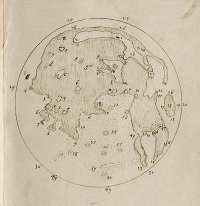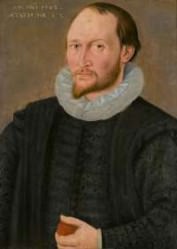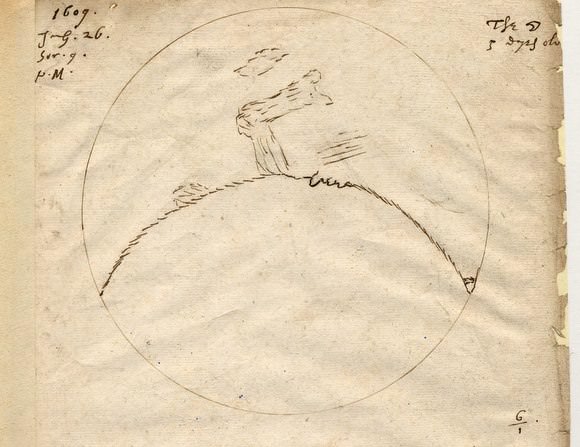[/caption]
Italian Galileo Galilei has usually been attributed with making the first celestial observations with a telescope and then creating notations and drawings to record his observations. And that’s the focus of what’s being celebrated during this International Year of Astronomy. But a British historian is taking this opportunity to publicize the work of another astronomer, Thomas Harriot, who actually was the first person to create drawings of the what the Moon looks like through a telescope, doing so well before Galileo. Historian Allan Chapman says dated maps prove that Harriot drew Moon maps several months earlier than Galileo, in July 1609. You can hear Chapman talk about Harriot in today’s 365 Days of Astronomy Podcast.
Chapman says that according to historical documents, Harriot used a ‘Dutch trunke’ (telescope), and turned it towards the Moon on July 26, 1609, and created drawings, becoming the first astronomer to do so.
Historical documents show Galileo first observed the moons of Jupiter on January 7, 1610, and later made drawings of Earth’s moon.
Harriot’s crude drawings show a rough outline of the lunar terminator (the line marking the division between night and day on the Moon, as seen from the Earth) and includes a handful of features like the dark areas Mare Crisium, Mare Tranquilitatis and Mare Foecunditatis.

Harriot went on to produce further maps from 1610 to 1613. Not all of these are dated, but they show an increasing level of detail. By 1613 he had created two maps of the whole Moon, with many identifiable features such as lunar craters that crucially are depicted in their correct relative positions.

But Harriot remains relatively unknown. Unlike Galileo, he did not publish his drawings. Dr. Chapman attributes this to his comfortable position as a ‘well-maintained philosopher to a great and wealthy nobleman’ with a generous salary. Harriot had comfortable housing and a specially provided observing chamber on top of Sion House, all of which contrasted with Galileo’s financial pressures.
Dr. Chapman believes that the time has come to give Harriot the credit he deserves. “Thomas Harriot is an unsung hero of science. His drawings mark the beginning of the era of modern astronomy we now live in, where telescopes large and small give us extraordinary information about the Universe we inhabit.”
Source: RAS


Harriot is certainly not an “unsung hero” in the U.K.: The IYA planners there have stressed its role since at least 2007 and actually built their timetable of main public observing events around the 400th anniversary of his first Moon drawing.
The IYA was an Italian idea, and they fought hard – for all of us – to get it recognized, eventually even by the U.N. No wonder that Galileo was the only “star” initially.
When the support for the IYA grew, however, both Harriot (mainly in the U.K.) and Kepler (in Germany and elsewhere) were kind of integrated into the celebrations, with different countries emphasizing different achievements. If that’s the only problem that 136 countries(!) have with each other …
“Chapman says that according to historical documents, Harriot used a ‘Dutch trunke’ (telescope), and turned it towards the Moon on July 26, 2009, and created drawings, becoming the first astronomer to do so.”
Thus proving that Harriot may be the first time traveller. Hooray !!
Sorry for the nitpick
Arrrgg! Sorry for the typo — the date has been fixed. Thanks for noticing the error.
I would like to point out the fact that not publishing the results makes a big difference. A discovery has little or no meaning if it’s kept in a drawer, unknown to the public. With his books, Galileo promoted a new way to approach nature and science, and this is way more important than being the first putting the eye on a telescope.
Lets get the facts straight.
Neither Harriott nor Galileo were the first to use a telescope to look at the heavens. A contemporaneous pamphlet describing the earliest events of Lipperhey’s introduction of the telescope shows that it was immediately pointed towards the heavens. The very first edition of this pamphlet probably appeared in late September, 1608. Quoting an English translation of the pamphlet, “… & even the stars which normally are not visible for us, because of the scanty proportion and feeble sight of our eyes, can be seen with this instrument.” Unfortunately, the writer (unknown, but a witness to the demonstration of the first telescope) does not say WHO look at the stars that September. But it was certainly before Harriott or Galileo.
Then, not much happened until several months later, when Harriott got hold of a telescope. Harriott grasped its usefulness for astronomy and he put his telescope to good use, but Harriott’s work pales in comparison to Galileo’s. Galileo, while not the first to look at stars or the moon, paved the road for every astronomer to follow.
Daniel Fischer said;
“The IYA was an Italian idea, and they fought hard – for all of us – to get it recognized, eventually even by the U.N.”
Boy now have I’ve got steam coming out of my ears!
I really appreciate the frank candour and origins of the “International Year of Astronomy”, but for heavens sake, forget the differences behind and just PROMOTE ASTRONOMY in 2009!!! (By 2010 it will be over!)
I ask you. If 2008 was the U.N.’s International Year of the Potato, did you decide to eating more potatoes or be even aware was last year celebrated? If not, then would you not say the promotion failed absolutely dismally? Did the FAO (Food and Agriculture Organisation) change the world?
Salacious B. Crumb Said:
Boy now have I’ve got steam coming out of my ears!
I thought it was kind of humid in here. Stop that!
In reality, is it not the man who overcame the most obstacles, who put his ass on the line and faced down the fanatics of his time who earned his place in history as a pioneer in the field of astronomy?
Or does this distinction belong to some spoiled panderer of propaganda who said what he got paid to say and kept his possibly falsely dated moonscapes hidden away until the furor had subsided like the pompous twit he truly was?
Or am I just pissed off because I’m sick of the privileged rewriting history every chance they get. Take your pick.
England already has Newton and Shakespeare, why do they need to grab for more past glory?
Harriot may have been first, but he did not announce his results to the world and did little to promote astronomy publicly. Galileo risked his life and reputation to change how we viewed the Universe.
Plus compare Harriot’s moon drawing to Galileo’s – my kids could do a better sketch than what Harriot did. I would almost be embarassed to show off such a thing. By comparison, Galileo did a real work of art.
It is the ones who change their world for the better while they are alive who matter.
Galeleo was my idol wanna follow in his footsteps!
~Fawn?